









The magazine of the art-form of the photo-essay
“A free, really high quality photo-essay magazine. Fabulous!”
Stephen Fry. British actor, writer and film & documentary maker

July 2015 back issue
by Araminta de Clermont





This body of work documents tattooed members of the South African prisons’ “Number” gangs, who, on release,
struggle to reintegrate into normal society due to their heavy tattooing.
In prison, the subjects of these photographs are Kings. Once out in the world, their appearance serves to class them
as dangerous criminals, provoking fear and distaste in the general public. Many are now homeless or ‘strollers’, unable
to get jobs and suffering high levels of alcohol/drug abuse. They have become branded, as it were, by their tattoos.
In keeping with their personal, and often violent histories, in and then out of prison, many of these gangsters possess
scars and even amputated limbs; thus photographing these men also became an exploration of the extent to which the
human body can tell the story of its inhabitant’s passage through life.
The subjects of these portraits (always photographed in their own environments) were found in hidden places:
homeless shelters, broken-down tenement blocks, under bridges, in back alleys, townships, soup kitchens and bus
stations…
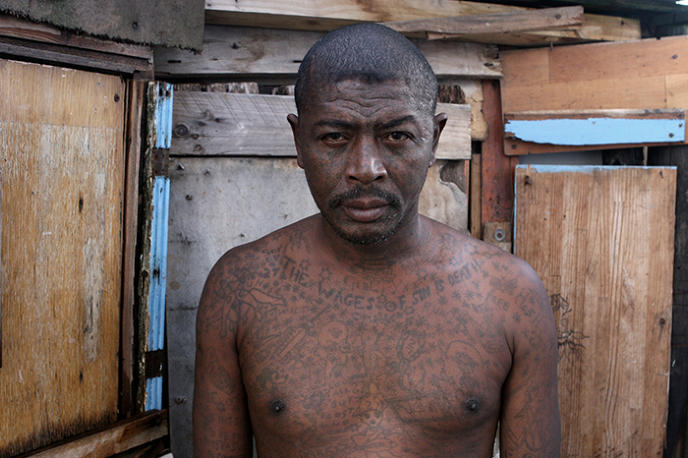
Akim.
Akim was a 27 in prison. It is said that to become a 27 is a life-long commitment to “The Number”, to remaining in
prison, and to leading a life of extreme violence. 27s are much feared, they have been likened to the gangs’
executioners. Holding the laws of The Number, they have immense power. It is rare to find a 27 outside of prison.
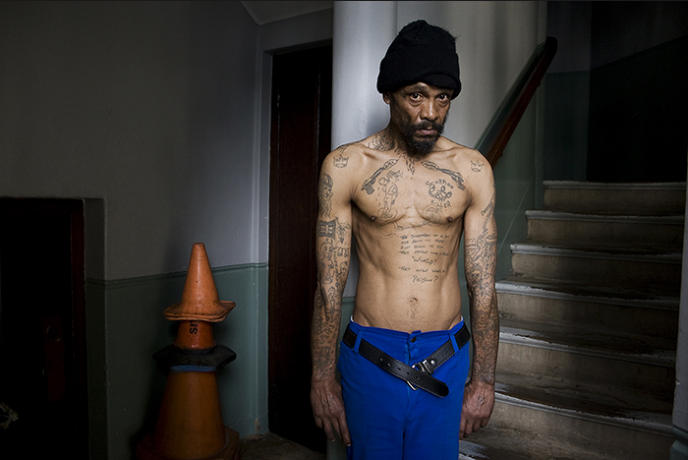
Ali.
Ali is very quiet and reserved. Since leaving prison, he has found work, as a cleaner/handyman at a church in Cape
Town. He lives in a bare room at the back, which is always scrubbed clean. His blankets are rolled regimentally.
The crowns on the front of Ali’s shoulders show his former high-ranking. His eyelids are tattooed with the words “Son”
& “Af”. (a slogan specific to his gang). Amongst his many tattoos, there are several relating to the struggle against
apartheid, including the crossed smoking guns across his chest with the words “black” and “organisation”.
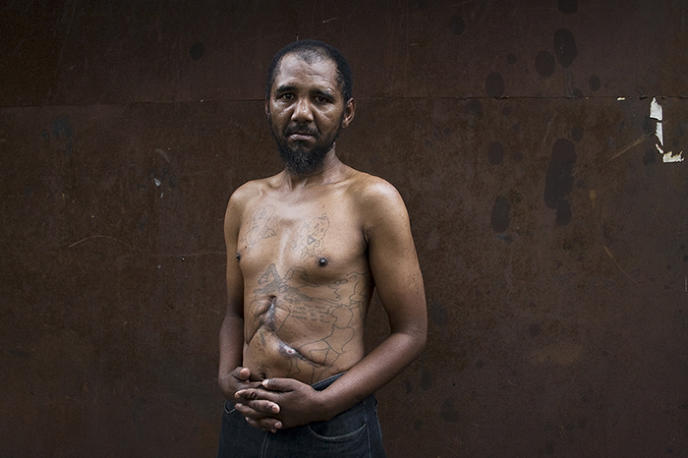
Anwar.
So prevalent is violence in South African prisons that the authorities have admitted in the past that they are unable
guarantee the safety of a prisoner in their “care”. A scar running right up the middle of the torso is a common sight.
This is often the result of an emergency operation having to be performed when a vital organ has been pierced during a
fight, or severe internal bleeding has occurred. Prisoners may swallow and repeatedly continue to swallow packages of
drugs they have managed to get inside. If these explode in the stomach, and the drugs are deemed too precious to
lose, cell-mates may perform their own amateur operations. Resultant scarring in this instance is particularly intense.
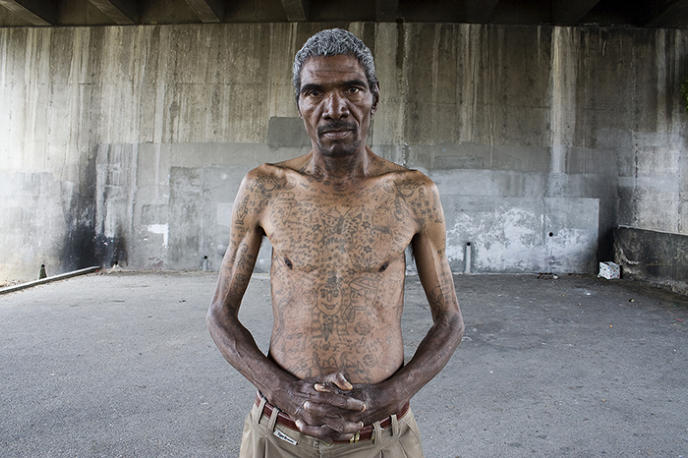
Frank.
Frank initially received a 3 year sentence for fighting. Having joined the Number gangs, he ended up killing a man in
prison, for which he was given the death sentence. Expecting to die in prison, he embraced full facial tattooing, but
with Mandela’s reprieve he was released after 27 years in prison. He died of pneumonia soon after this photograph
was taken.
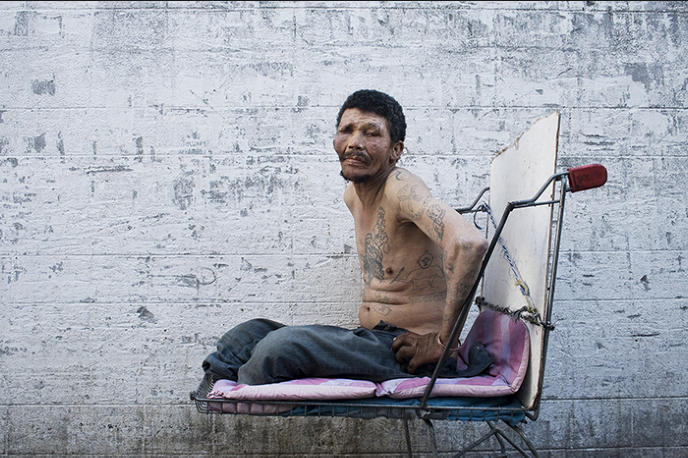
Johannis.
Johannis got hit by a car, and lost both his legs after his release from prison. Many ex-prisoners have problems with
alcohol or drugs as they struggle to re-integrate into the outside world. Johannis, who is homeless, has been given
second hand wheelchairs several times, but they are quickly stolen on the streets. Other former members of the
Number gangs will carry or ferry him around, using shopping trolleys, makeshift skateboards, or whatever they can
find.
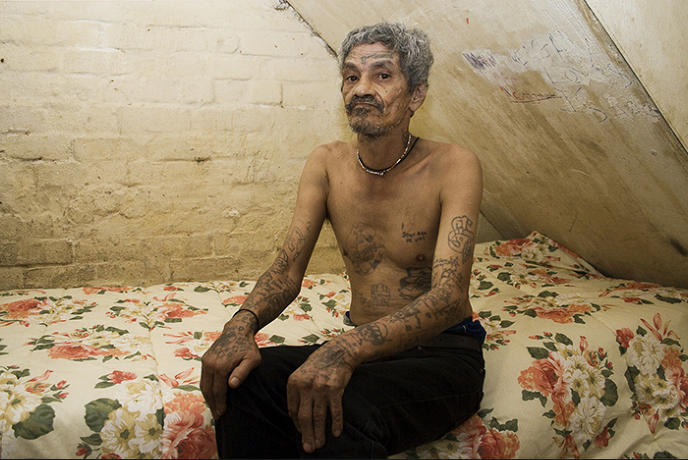
Joseph.
It is difficult to remove tattoos. Laser treatment and skin grafts are totally out of most former prisoners’ budgets. Those
with tattoos on the face may be so desperate to remove them that the offending skin is sometimes burnt, and then cut
off with nail-clippers. This leaves terrible scarring. There are also stories of abrasive household cleaning-products being
scrubbed on tattoos daily, in an attempt to get them to fade. Joseph has covered a particularly offensive insult, which
was written across his forehead, with a tattoo of a wine bottle.
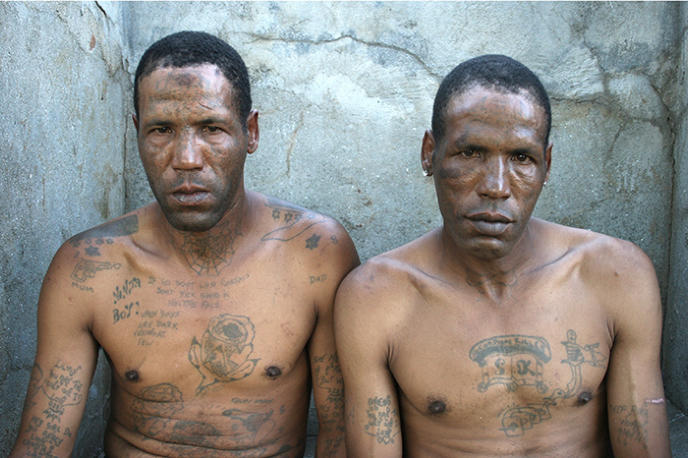
Bless and Kojak.
Bless and Kojak spent 19 years in prison for the same crime, and served their sentences at different prisons. Now
released, they have found one another again. Bless has found work as “security” at a street market in central Cape
Town. He says his tattooed presence was enough to put off most shoplifters. Kojak has found work at a construction
company run by an old friend.
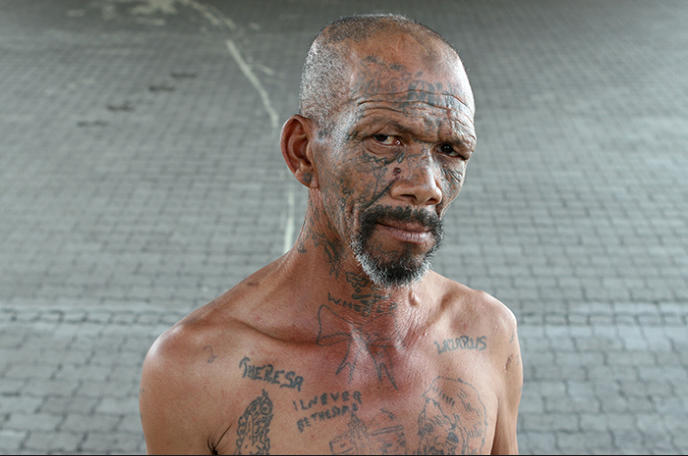
Lazarus.
Tattooing has been forbidden in South African prisons (punishable by reduced rations, solitary confinement, or days
added to the sentence). So the tattooing of the face, apart from signifying a total dedication to the gang, can in some
cases be read as a particular message to the wardens that the prisoner has absolutely no respect for their authority.
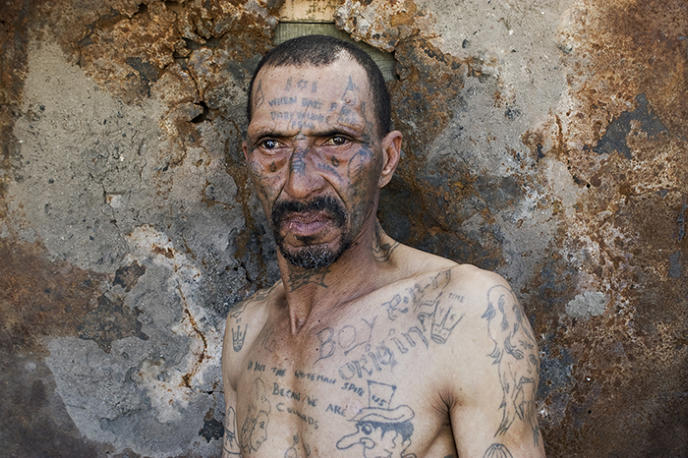
Lewis.
Lewis has been in and out of prison for decades. Rejected by his family because of the shame of his tattoos, and
struggling to find work, he used to believe that the only option he had to survive was to mug people. His tattooed face
terrified people so much he said, that he never had any problems getting people to hand over their money once they
saw him.
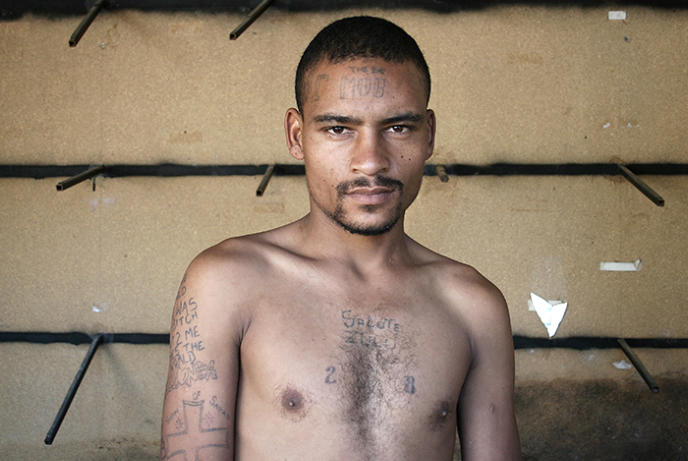
Marawaun.
The gallows used to be the tattoo for those condemned to the gallows. Nowadays the mark signifies “baddest of the
bad”.
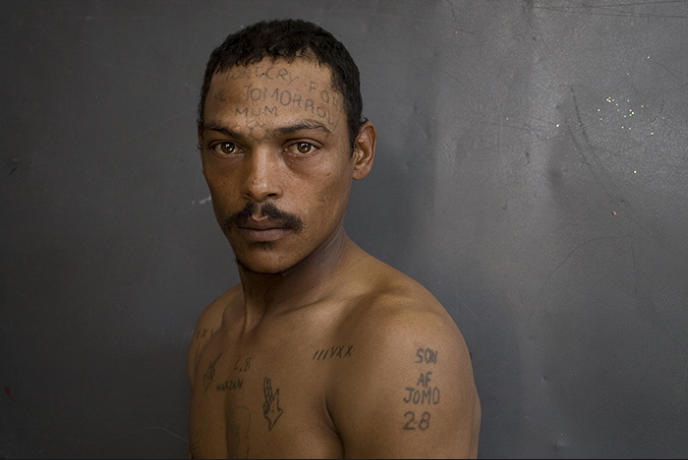
Martin.
Martin was on the streets from the age of 8, and has been in and out of boys institutions, and prison ever since. The
tattoo on his head is a message to his mother, who he says was never there for him.
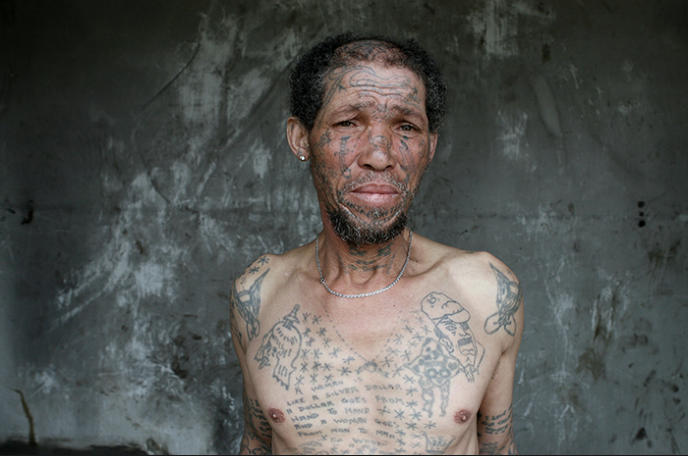
Moerser.
Moerser, was a significant figure in prison. He now collects scrap-metal and spends his days with other homeless
people, sleeping rough in the middle of a traffic circle in an industrial area of Cape Town. A tattooed insect like this one,
especially on the face or nose, shows bad intentions.
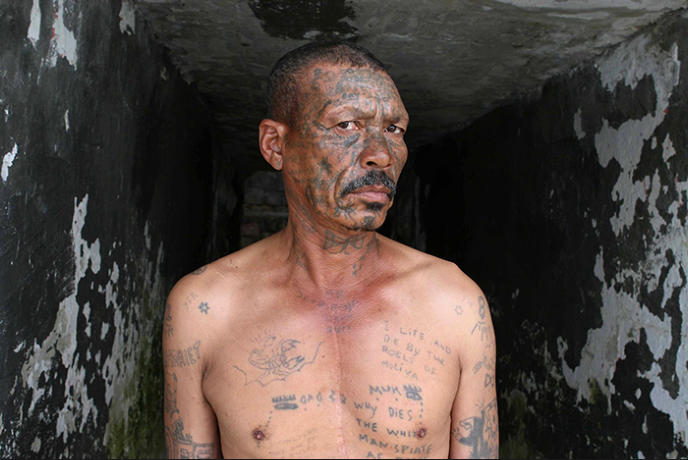
Mr Green.
With no real constructive pass-times, and perhaps 23 out of 24 hours spent in a severely overcrowded cell, boredom is
repeatedly cited as a reason for prolific tattooing. Even if there is access to a television, having an unrestricted view of
it, and being able to concentrate is unlikely. Again and again the men told me that tattooing was a great way of whiling
away the hours. It was described as becoming almost addictive in some cases.
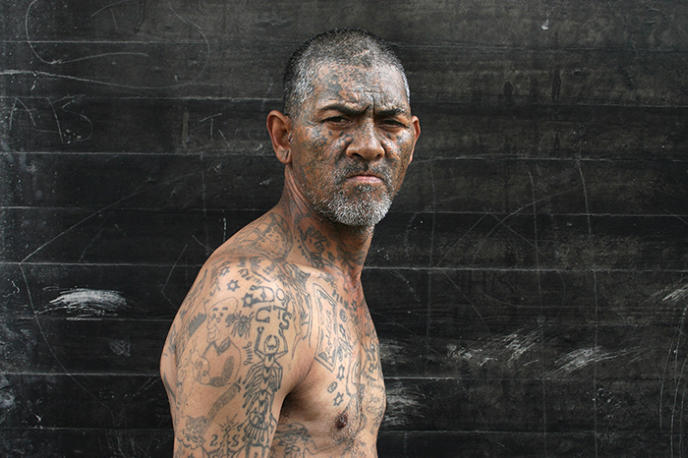
Omar.
A member of The Number can read another’s life story, and position in the gang hierarchy, simply by the marks on his
body. Omar got 30 days solitary confinement and basic rations for tattooing his face, but he doesn’t regret it all, and
never has, he says. “It is part of who I am”.
Omar is also known as “Chappies” (the slang prison term for the tattoos), because he is so covered with tattoos…The
term “chappies” comes from the popular bubble gum sold in South Africa, whose wrappers are covered on the inside
with tiny “did you know?” facts.
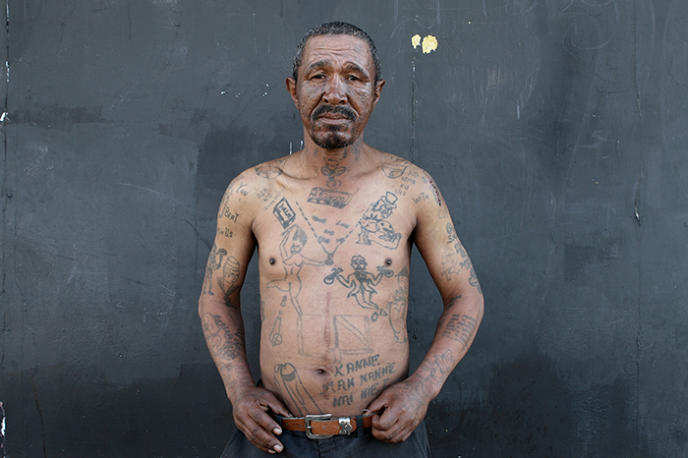
Stone.
Machismo is a big issue in prisons, where angry and lonely men are crammed together in incredibly close-proximity.
Male rape is commonplace, as is sex between consenting men who may not be gay “on the outside”.
The question of whether sex between men is acceptable, is one of the factors that separates “The Number” gangs,
the 26s and 27s apparently reviling it, and the 28s supposedly embracing it. The 28s have in fact 2 factions: the
“blood-line” or fighters, and their “wyfies” who receive protection in prison in return for performing sexual and domestic
duties.
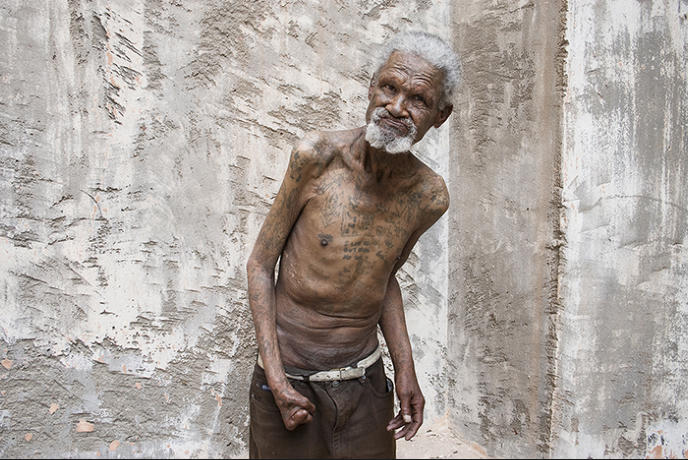
Stranger.
As befitting a man who has embraced The Number to the extent of full-body tattooing, there is an abundance of
folklore about Stranger: his hand becoming fused shut around his stolen money as he entered prison for example. It is
also said that as a high-ranking member of the Number he never had to leave his bed in prison, unless he wanted to.
Minions would come to him as he lay, to wash and shave him, such was his power.
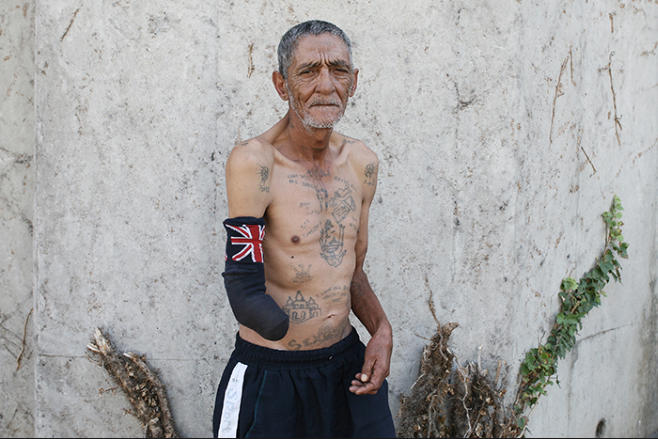
Tamate.
Nicknamed tomato in prison because tomatoes run red and “bleed”.
After his time in prison, Tamate became hooked on the tranquiliser Mandrax (a smoke-able form of Quaalude. He
was attacked by a fighting dog, while passed out and sleeping rough. The injuries were so bad that he lost his
arm.






